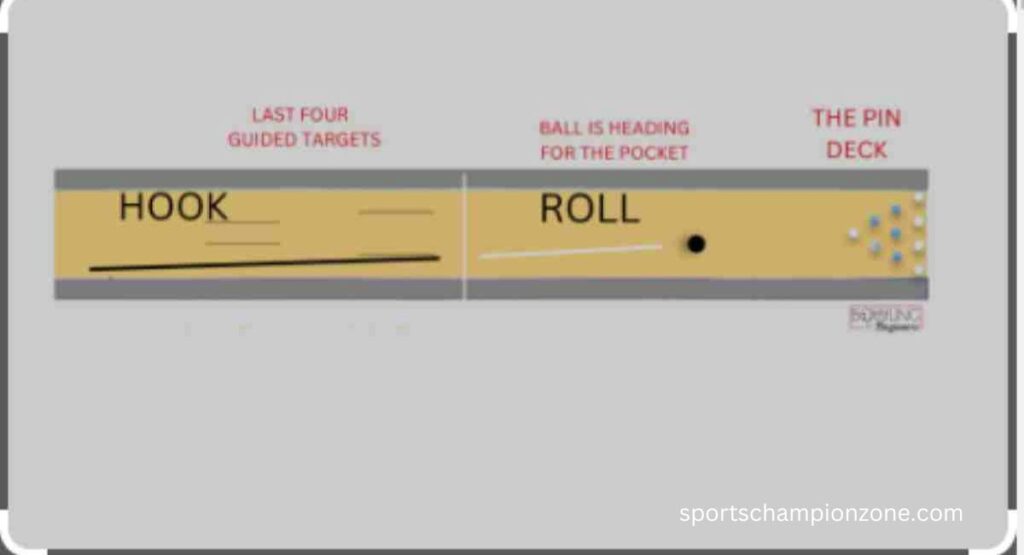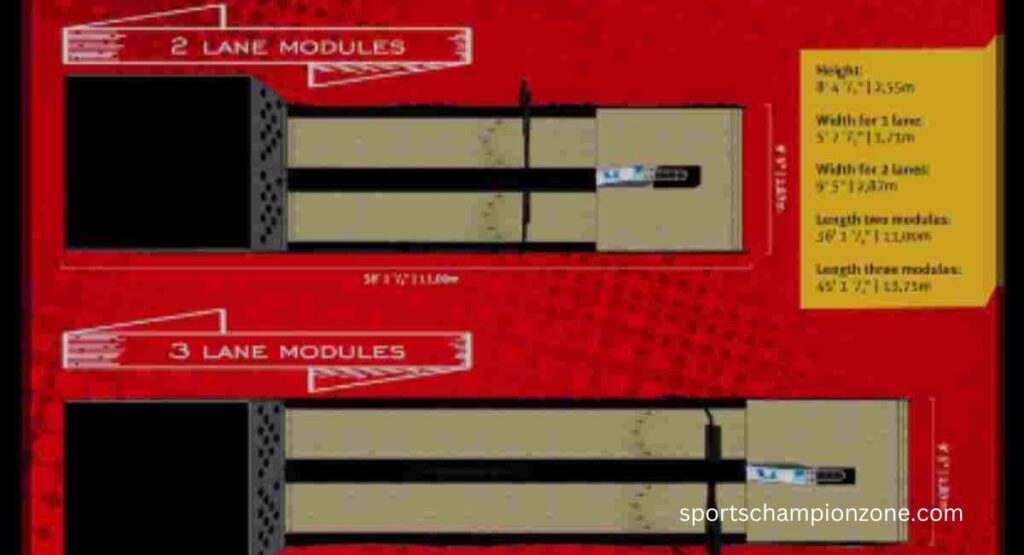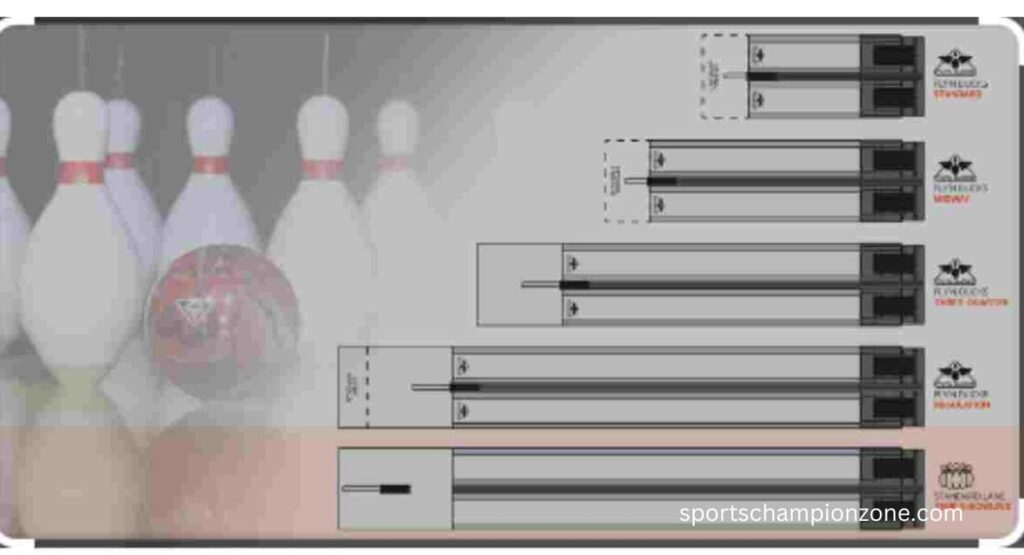A bowling lane length is 60 feet in length and 40 inches in wide. The length being estimated from the head pin to the foul line. The complete length of bowling line with front and back administrations region is (27m) and width is (2m). bowling drains have a profundity of (46mm) and width is (24cm). A bowling lane is a straight rectangular line with two (2) drain alongside the side for wailing balls.
The Bowling lane guideline bowling lane is 60 feet in length. Envision it as a long, limited way intended for the ideal roll of the bowling ball. This length envelops different key regions that add to the general insight.

Components of a Bowling Lane Length
Bowling lane length is appear to be basic for start there are there’s something else to them besides what might be immediately. We should investigate the different parts that make up a bowling path, from the methodology region to the pin deck.
Approach Area:
The methodology region is where bowlers stand before they discharge the ball. It resembles the beginning stage of the bowling venture. This piece of the path is generally made of a smooth, wooden surface or manufactured material. Bowlers make their strides and gather speed here prior to delivering the ball towards the pins.
Foul Line:
The foul line denotes the limit between the methodology region and the primary path. It’s a basic line that bowlers should not cross while delivering the ball. In the event that a bowler ventures over this line, it’s viewed as a foul, and any pins wrecked on that toss won’t figure in with their score.
Lane Surface:
The path surface is the long, restricted segment where the ball rolls towards the pins. It’s painstakingly created to give a perfect proportion of rubbing and perfection for the ball to flawlessly travel. Paths can be made of wood or manufactured materials, each with its own attributes influencing ball conduct.
Lane Markings:
Lane markings assist bowlers with their arrangement and focusing on. You’ll frequently see bolts and spots on the path, demonstrating different pointing focuses for bowlers. These markings are urgent for keeping up with consistency in shots and adapting to changing path conditions.

Oil Patterns:
Bowling lane are not simply level surfaces; they’re painstakingly oiled to make explicit examples. Oil designs influence how the ball acts as it goes down the path. Different oil examples can make the ball snare pretty much, influencing the technique and ability expected to play the game.
Gutters:
On one or the other side of the lane are drains, otherwise called channels. On the off chance that a ball goes into the drain, it’s out of play and won’t hit any pins. Drains can be scary for novices, yet they’re a fundamental piece of the game, adding a component of challenge and expertise in keeping the ball on track.
Pin Deck:
Toward the finish of the path is the pin deck, where the pins are set up. The pin deck is normally made of a hard material like wood or manufactured material to endure the effect of the pins. It’s where the activity works out – where the ball plans to wreck however many pins as would be prudent.
Pins:
To wrap things up, we have the superstars – the pins! Pins are set up in a three-sided development on the pin deck. The objective of the game is to wreck however many pins as you can with each toss. Each pin thumped down procures focuses, and a definitive objective is to thump down every one of the ten pins in a solitary casing.

Explanation of Bowling Lane Length
A bowling lane is the long, restricted surface where you play the sport of bowling. It resembles a major pathway for the bowling ball to move down towards the pins at the opposite end. The length of a bowling path is the manner by which far it extends from where you stand to toss the ball, to where the pins are set up toward the end.
Presently, the standard length of a bowling lane length is around 60 feet. To provide you with a thought of how long that is, it’s generally the length of two school transports stopped start to finish! Envision remaining toward one side of this long lane and attempting to move a ball the whole way to the opposite finish to thump down the pins.
Toward the start of the lane, there’s a line called the “foul line.” You really want to remain behind this line while you’re tossing the ball. Your objective in bowling is to move the ball down the lane and wreck however many pins as you can. The pins are organized in a particular example, with the tallest pin, called the “head pin,” solidly in the center.
Thus, while you’re bowling, you’re basically intending to move the ball down this 60-foot lane precisely enough to wreck however many pins as would be prudent. It requires expertise, accuracy, and a touch of karma! Keep in mind, while 60 feet is the standard length for a bowling path, there may be slight varieties relying upon the particular bowling alley or office you’re playing in. Yet, no matter what the specific length, the thought is something similar: roll the ball down the lane and go for the gold at the opposite.

Importance of Lane
The of a bowling lane length could seem like simply a number, yet it’s entirely significant in the sport of bowling. Here’s the reason:
First and foremost, lane length influences the speed and force of the bowling ball. A more drawn out lane gives the ball more distance to develop speed as it rolls towards the pins. This implies that bowlers need to change their tossing method and timing in view of the length of the lane. It adds a component of challenge and expertise to the game, expecting bowlers to adjust their way to deal with various bowling lane lengths.
Bowling lane length impacts the procedure and strategies utilized by bowlers. In a more drawn out path, the ball has additional opportunity to snare or bend towards the pins. This implies that bowlers could have to utilize various sorts of shots to explore the path and hit the pins with precision. Understanding what path length means for ball conduct permits bowlers to settle on better conclusions about where to point and how much ability to use in their tosses.
Lane length can affect the general insight of bowling. A more extended path can make a feeling of expectation and fervor as the ball goes down the path towards the pins. It additionally gives more space to observers to watch and applaud the bowlers. Then again, a more limited path could feel all the more speed and serious, with less wiggle room in each toss.
Bowling lane length can shift between various bowling alleys and offices. This changes up the game and keeps it fascinating for bowlers of all expertise levels. Whether you’re playing on a short path or a long path, each experience offers its own extraordinary difficulties and valuable open doors for progress.
The bowling lane length is something other than an estimation – a key component impacts the speed, procedure, and generally speaking experience of the game. By understanding the significance of bowling lane length, bowlers can upgrade their abilities and pleasure in the game. So next time you step onto the paths, pause for a minute to see the value in the job that path length plays in the sport of bowling.
How many Meters is a bowling lane?
A standard bowling lane length measures 18.29 meters long. This distance is steady across most bowling alleys around the world. It gives adequate space to players to move the ball from the methodology region to the pins toward the finish of the path. The length of the lane is essential for the game’s elements, permitting players to point and apply different procedures to accomplish their ideal scores. Whether for easygoing tomfoolery or cutthroat play, the components of the bowling path stay an essential part of the game, guaranteeing a fair and steady insight for bowlers, everything being equal.
What is the last 15 feet of a bowling lane called?
The last 15 feet of a bowling lane is commonly referred to as the “pin deck” or simply “the deck.” This section is where the ten bowling pins are set up for players to aim and knock down. It’s a critical area of the lane where the final action of each roll takes place. Bowlers often focus intensely on this part of the lane, as it determines their success in scoring points. The pin deck is designed to ensure pins fall and reset efficiently, maintaining the flow of the game and providing an exciting finish to each frame.
How many bowls is 1 game of bowling?
In one round of bowling, every player commonly bowls ten edges. During each casing, a player has the chance to move the ball two times, besides in specific conditions like strikes or extras. This really intends that altogether, a player tosses a limit of 20 balls in a game, planning to wreck however many pins as would be prudent with each roll. The game’s goal is to amass the most elevated score conceivable by decisively thumping down pins and benefiting from extra focuses granted for strikes and extras.
What is line and length in bowling?
In bowling, “line” alludes to the bearing where the ball goes towards the pins. Bowlers mean to convey the ball along a particular way on the lane to expand their possibilities raising a ruckus around town really. “Length” alludes to where the ball lands on the lane corresponding to its separation from the pins. Bowlers mean to control both the line and length of their conveyances to target explicit region of the pin deck for ideal outcomes, like raising a ruckus around town for a strike or setting up spare open doors. Dominating line and length is fundamental for outcome in bowling.
Conclusion:
The bowling lane length holds critical significance, affecting different parts of the game. From impacting the speed and energy of the bowling ball to forming the procedures utilized by bowlers, path length assumes a urgent components in deciding the result of each toss. One of the essential impacts of path length is its effect on the speed and direction of the bowling ball. A more drawn out path permits the ball more distance to in like manner gain speed, expecting bowlers to change their tossing method.
Besides, bowling lane length shapes the essential choices made by bowlers during interactivity. In longer paths, bowlers possess more energy for the ball to snare or bend towards the pins, provoking them to use various shots and points to boost precision. On the other hand, a more limited path requires faster deliveries and accuracy to arrive at the pins with adequate power. Understanding what path length means for ball conduct is fundamental for bowlers to adjust their methodology and accomplish predictable outcomes.
If you want to more and better information you can also visit
1. https://en.wikipedia.org/wiki/Bowling_alley
2. https://www.dlgsc.wa.gov.au/sport-and-recreation/sports-dimensions-guide/tenpin-bowling
3. http://news.bbc.co.uk/sport2/hi/cricket/skills/4177344.stm
